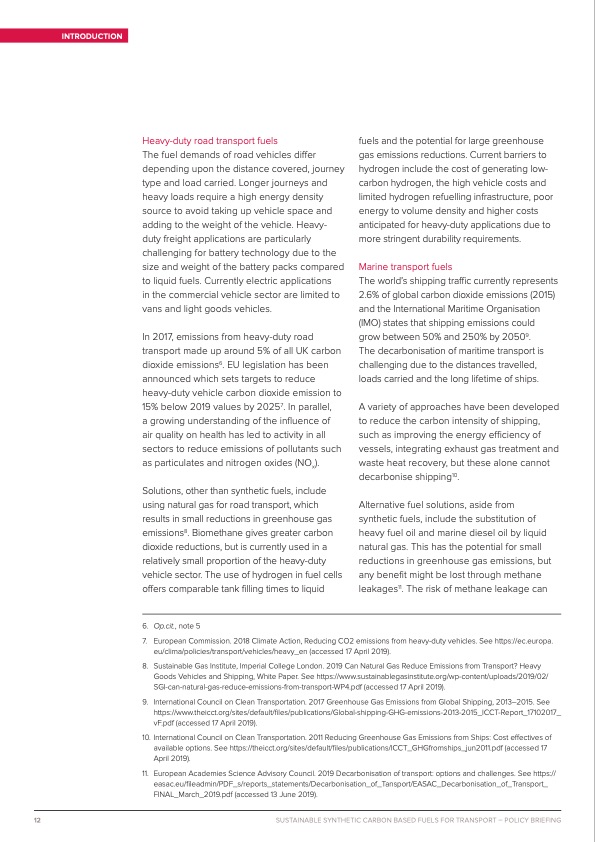
PDF Publication Title:
Text from PDF Page: 012
INTRODUCTION heavy-duty road transport fuels The fuel demands of road vehicles differ depending upon the distance covered, journey type and load carried. Longer journeys and heavy loads require a high energy density source to avoid taking up vehicle space and adding to the weight of the vehicle. heavy- duty freight applications are particularly challenging for battery technology due to the size and weight of the battery packs compared to liquid fuels. Currently electric applications in the commercial vehicle sector are limited to vans and light goods vehicles. In 2017, emissions from heavy-duty road transport made up around 5% of all uK carbon dioxide emissions6. Eu legislation has been announced which sets targets to reduce heavy-duty vehicle carbon dioxide emission to 15% below 2019 values by 20257. In parallel, a growing understanding of the influence of air quality on health has led to activity in all sectors to reduce emissions of pollutants such as particulates and nitrogen oxides (NOx). Solutions, other than synthetic fuels, include using natural gas for road transport, which results in small reductions in greenhouse gas emissions8. Biomethane gives greater carbon dioxide reductions, but is currently used in a relatively small proportion of the heavy-duty vehicle sector. The use of hydrogen in fuel cells offers comparable tank filling times to liquid 6. Op.cit.,note5 fuels and the potential for large greenhouse gas emissions reductions. Current barriers to hydrogen include the cost of generating low- carbon hydrogen, the high vehicle costs and limited hydrogen refuelling infrastructure, poor energy to volume density and higher costs anticipated for heavy-duty applications due to more stringent durability requirements. Marine transport fuels The world’s shipping traffic currently represents 2.6% of global carbon dioxide emissions (2015) and the International Maritime Organisation (IMO) states that shipping emissions could grow between 50% and 250% by 20509. The decarbonisation of maritime transport is challenging due to the distances travelled, loads carried and the long lifetime of ships. A variety of approaches have been developed to reduce the carbon intensity of shipping, such as improving the energy efficiency of vessels, integrating exhaust gas treatment and waste heat recovery, but these alone cannot decarbonise shipping10. Alternative fuel solutions, aside from synthetic fuels, include the substitution of heavy fuel oil and marine diesel oil by liquid natural gas. This has the potential for small reductions in greenhouse gas emissions, but any benefit might be lost through methane leakages11. The risk of methane leakage can 7. 8. 9. 10. 11. European Commission. 2018 Climate Action, Reducing CO2 emissions from heavy-duty vehicles. See https://ec.europa. eu/clima/policies/transport/vehicles/heavy_en (accessed 17 April 2019). SustainableGasInstitute,ImperialCollegeLondon.2019CanNaturalGasReduceEmissionsfromTransport?heavy Goods Vehicles and Shipping, White Paper. See https://www.sustainablegasinstitute.org/wp-content/uploads/2019/02/ SGI-can-natural-gas-reduce-emissions-from-transport-WP4.pdf (accessed 17 April 2019). InternationalCouncilonCleanTransportation.2017GreenhouseGasEmissionsfromGlobalShipping,2013–2015.See https://www.theicct.org/sites/default/files/publications/Global-shipping-GhG-emissions-2013-2015_ICCT-Report_17102017_ vF.pdf (accessed 17 April 2019). International Council on Clean Transportation. 2011 Reducing Greenhouse Gas Emissions from Ships: Cost effectives of available options. See https://theicct.org/sites/default/files/publications/ICCT_GhGfromships_jun2011.pdf (accessed 17 April 2019). EuropeanAcademiesScienceAdvisoryCouncil.2019Decarbonisationoftransport:optionsandchallenges.Seehttps:// easac.eu/fileadmin/PDF_s/reports_statements/Decarbonisation_of_Tansport/EASAC_Decarbonisation_of_Transport_ FINAL_March_2019.pdf (accessed 13 June 2019). 12 SuSTAINABLE SYNThETIC CARBON BASED FuELS FOR TRANSPORT – POLICY BRIEFINGPDF Image | Sustainable synthetic carbon based fuels for transport

PDF Search Title:
Sustainable synthetic carbon based fuels for transportOriginal File Name Searched:
synthetic-fuels-briefing.pdfDIY PDF Search: Google It | Yahoo | Bing
NFT (Non Fungible Token): Buy our tech, design, development or system NFT and become part of our tech NFT network... More Info
IT XR Project Redstone NFT Available for Sale: NFT for high tech turbine design with one part 3D printed counter-rotating energy turbine. Be part of the future with this NFT. Can be bought and sold but only one design NFT exists. Royalties go to the developer (Infinity) to keep enhancing design and applications... More Info
Infinity Turbine IT XR Project Redstone Design: NFT for sale... NFT for high tech turbine design with one part 3D printed counter-rotating energy turbine. Includes all rights to this turbine design, including license for Fluid Handling Block I and II for the turbine assembly and housing. The NFT includes the blueprints (cad/cam), revenue streams, and all future development of the IT XR Project Redstone... More Info
Infinity Turbine ROT Radial Outflow Turbine 24 Design and Worldwide Rights: NFT for sale... NFT for the ROT 24 energy turbine. Be part of the future with this NFT. This design can be bought and sold but only one design NFT exists. You may manufacture the unit, or get the revenues from its sale from Infinity Turbine. Royalties go to the developer (Infinity) to keep enhancing design and applications... More Info
Infinity Supercritical CO2 10 Liter Extractor Design and Worldwide Rights: The Infinity Supercritical 10L CO2 extractor is for botanical oil extraction, which is rich in terpenes and can produce shelf ready full spectrum oil. With over 5 years of development, this industry leader mature extractor machine has been sold since 2015 and is part of many profitable businesses. The process can also be used for electrowinning, e-waste recycling, and lithium battery recycling, gold mining electronic wastes, precious metals. CO2 can also be used in a reverse fuel cell with nafion to make a gas-to-liquids fuel, such as methanol, ethanol and butanol or ethylene. Supercritical CO2 has also been used for treating nafion to make it more effective catalyst. This NFT is for the purchase of worldwide rights which includes the design. More Info
NFT (Non Fungible Token): Buy our tech, design, development or system NFT and become part of our tech NFT network... More Info
Infinity Turbine Products: Special for this month, any plans are $10,000 for complete Cad/Cam blueprints. License is for one build. Try before you buy a production license. May pay by Bitcoin or other Crypto. Products Page... More Info
| CONTACT TEL: 608-238-6001 Email: greg@infinityturbine.com | RSS | AMP |